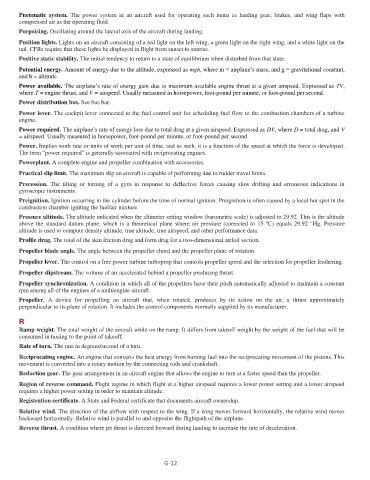Page 384 - Airplane Flying Handbook
P. 384
Pneumatic system. The power system in an aircraft used for operating such items as landing gear, brakes, and wing flaps with
compressed air as the operating fluid.
Porpoising. Oscillating around the lateral axis of the aircraft during landing.
Position lights. Lights on an aircraft consisting of a red light on the left wing, a green light on the right wing, and a white light on the
tail. CFRs require that these lights be displayed in flight from sunset to sunrise.
Positive static stability. The initial tendency to return to a state of equilibrium when disturbed from that state.
Potential energy. Amount of energy due to the altitude, expressed as mgh, where m = airplane’s mass, and g = gravitational constant,
and h = altitude.
Power available. The airplane’s rate of energy gain due to maximum available engine thrust at a given airspeed. Expressed as TV,
where T = engine thrust, and V = airspeed. Usually measured in horsepower, foot-pound per minute, or foot-pound per second.
Power distribution bus. See bus bar.
Power lever. The cockpit lever connected to the fuel control unit for scheduling fuel flow to the combustion chambers of a turbine
engine.
Power required. The airplane’s rate of energy loss due to total drag at a given airspeed. Expressed as DV, where D = total drag, and V
= airspeed. Usually measured in horsepower, foot-pound per minute, or foot-pound per second.
Power. Implies work rate or units of work per unit of time, and as such, it is a function of the speed at which the force is developed.
The term “power required” is generally associated with reciprocating engines.
Powerplant. A complete engine and propeller combination with accessories.
Practical slip limit. The maximum slip an aircraft is capable of performing due to rudder travel limits.
Precession. The tilting or turning of a gyro in response to deflective forces causing slow drifting and erroneous indications in
gyroscopic instruments.
Preignition. Ignition occurring in the cylinder before the time of normal ignition. Preignition is often caused by a local hot spot in the
combustion chamber igniting the fuel/air mixture.
Pressure altitude. The altitude indicated when the altimeter setting window (barometric scale) is adjusted to 29.92. This is the altitude
above the standard datum plane, which is a theoretical plane where air pressure (corrected to 15 ºC) equals 29.92 "Hg. Pressure
altitude is used to compute density altitude, true altitude, true airspeed, and other performance data.
Profile drag. The total of the skin friction drag and form drag for a two-dimensional airfoil section.
Propeller blade angle. The angle between the propeller chord and the propeller plane of rotation.
Propeller lever. The control on a free power turbine turboprop that controls propeller speed and the selection for propeller feathering.
Propeller slipstream. The volume of air accelerated behind a propeller producing thrust.
Propeller synchronization. A condition in which all of the propellers have their pitch automatically adjusted to maintain a constant
rpm among all of the engines of a multiengine aircraft.
Propeller. A device for propelling an aircraft that, when rotated, produces by its action on the air, a thrust approximately
to
perpendicular its plane of rotation. It includes the control components normally supplied by its manufacturer.
R
Ramp weight. The total weight of the aircraft while on the ramp. It differs from takeoff weight by the weight of the fuel that will be
consumed in taxiing to the point of takeoff.
Rate of turn. The rate in degrees/second of a turn.
Reciprocating engine. An engine that converts the heat energy from burning fuel into the reciprocating movement of the pistons. This
movement is converted into a rotary motion by the connecting rods and crankshaft.
Reduction gear. The gear arrangement in an aircraft engine that allows the engine to turn at a faster speed than the propeller.
Region of reverse command. Flight regime in which flight at a higher airspeed requires a lower power setting and a lower airspeed
requires a higher power setting in order to maintain altitude.
Registration certificate. A State and Federal certificate that documents aircraft ownership.
Relative wind. The direction of the airflow with respect to the wing. If a wing moves forward horizontally, the relative wind moves
backward horizontally. Relative wind is parallel to and opposite the flightpath of the airplane.
Reverse thrust. A condition where jet thrust is directed forward during landing to increase the rate of deceleration.
G-12

